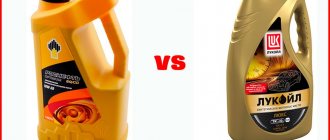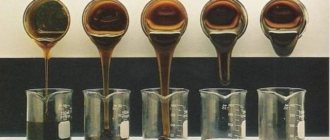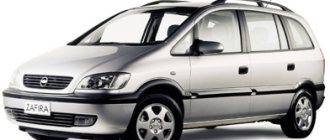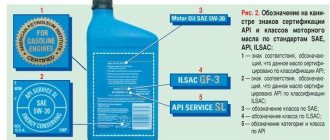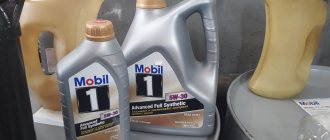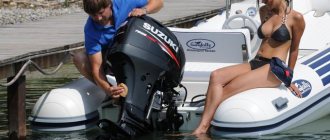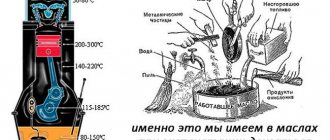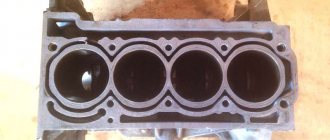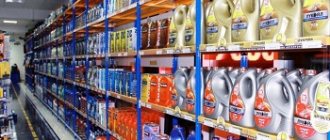Toyota Corolla E100 1991-2002
Model 1995
The selection of engine oil is carried out taking into account the type of engine of the car.
Gasoline power units
The manufacturer recommends that Toyota Corolla take SG, SH or SJ oil classes according to API standards. When selecting the thickness of the lubricant, you must use scheme 1 or 2.
Scheme 1. Recommended oil thickness for models produced before 1995.
According to this scheme, for the winter, when the air temperature is below +80C, it is better to use motor fluids with a viscosity parameter of 5w-30. The use of lubricants with a viscosity of 10w-30, 15w-40 or 20w-50 is advisable at temperatures above -180C; at lower temperatures, the use of these oils will lead to poor engine starting and increased consumption of the fuel mixture.
Scheme 2. Dependence of the viscosity of the motor fluid on the temperature of the region in which the car is operated (models equipped with gasoline engines since 1995).
* — model 4A-GE.
** - except for model 4A-GE.
According to Scheme 2 for Toyota Corolla, it is recommended to use the following lubricants:
- 10w-30 is poured at temperatures above -200C;
- 5w-30 is poured into the 4A-GE model if the thermometer is below +100C;
- in a wide temperature range, from -300C (and less) to +400C (and more), 5w-30 is used (except for the 4A-GE model).
Diesel car engines
According to the manual for Toyota Corolla, it is recommended to use the oil type CD, CE or CF according to the API classification. The viscosity of lubricating fluids for models produced before 1995 is selected according to Scheme 1, and for models since 1995, the selection of viscosity parameters is carried out according to Scheme 3.
Diagram 3. Recommended viscosity for models since 1995.
Based on the data in Scheme 2, at temperatures above -200C, 10w-30 is used. 5w-30 oils are used in regions with air temperatures below +100C.
Refueling volumes
The volume of engine oil between o and “minimum” on the dipstick is approximately 1 liter. Refueling tanks for Toyota Corolla:
- Engines 2E and 3E:
- 2.7 l with oil filter;
- 2.5 l excluding oil filter.
- Motors 4E-FE or 5E-FE:
- 2.8 l with filter replacement;
- 2.6 l without replacing the oil filter.
- Auto engines 5A-FE, 4A-FE(2WD):
- 3.0 l including oil filter;
- 2.8 l without replacing the oil filter.
- Power units 7A-FE:
- 3.7 l with oil filter;
- 3.5 without replacing the filter unit.
- 4A-GE engines:
- 3.0 l with filter replacement;
- 2.8 l without changing the oil filter.
- Power units 2C (until 1994):
- 4.7 l with oil filter;
- 4.2 l without oil filter.
- 2C (from 1994 to 1995):
- 4.3 l with filter replacement;
- 3.6 l excluding oil filter.
- Power units 2C (since 1995 2WD):
- 4.1 l with oil filter change;
- 3.4 l without replacing the oil filter.
- 2C engines (from 1995 4WD):
- 4.4 l with oil filter;
- 3.7 l without oil filter.
- Motors 3C-E(2WD):
- 5.1 l with oil filter;
- 4.4 l without filter device.
- Powertrains 3C-E(4WD):
- 4.9 with oil filter replacement;
- 4.2 l without changing the oil filter.
1ZRFE Service Regulations
Since the motor can quickly fail and major repairs will no longer help it, you should follow the maintenance schedule. For example, experienced mechanics recommend changing the oil every 10 thousand kilometers. For Russia, only 5W20 and 5W30 lubricants are used. Since they can withstand quite low temperatures.
Attention! To change the lubricant you will need 4.2 liters of engine oil. And the total volume is 4.7 liters.
Since the timing belt is a chain one, it is recommended to change the chain every 100 thousand kilometers. The chain should be inspected once every 50,000 kilometers in order to detect chips or other minor damage in time. Because a broken chain will cause irreversible damage to the 1 ZRFE engine.
Similar article Toyota Corolla engine characteristics
The air filter is changed after 30 thousand kilometers, and the fuel filter after 80 thousand kilometers. New spark plugs are installed after 40 thousand kilometers. Antifreeze is changed every five years. The coolant is enough for one hundred thousand kilometers of the car.
The auxiliary belt is changed after 100 thousand kilometers. But adjustment of the thermal clearances of the valves is not provided.
Toyota Corolla E110,E111 1997-2002
Photo of the car
According to the car's operating instructions, the recommended engine oil for Toyota Corolla is selected according to the engine type. For 2E 1.3L power units, you need to use CD, CE or CF brands of motor oils in accordance with the API system or lubricants of a higher quality class. The recommended grease thickness is indicated in diagram 4.
Scheme 4. The influence of air temperature on the selection of motor fluid viscosity for 2E 1.3l engines.
In accordance with scheme 4, it is recommended to use lubricants 15w-40, 20w-40 and 20w-50 if the temperature outside the car is above -90C. When the thermometer reading is above -23.50C, you should use liquids 10w-30, 10w-40 or 10w-50. If the temperature is less than +80C, then it is recommended to fill with 5w-30.
In the case of 4E-FE 1.3L power units, it is recommended to use oil type SG, SF or higher according to API requirements. The viscosity of the motor fluid is selected according to scheme 5.
Diagram 5. Recommended thickness of motor fluid for 4E-FE 1.3L car engines.
According to scheme 5, at temperatures below +80C, pour 5w-30. Motor oils 10w-30 are used when the temperature is above -180C, and 15w-40 or 20w-50 are poured if the temperature is above 12.50C.
For 4ZZ-FE 1.4 liter Toyota Corolla engines, you must use oils of at least SJ class according to the API system. You can also use energy-saving motor oils with the inscription “Energy Conserving” on the canister. The thickness of the recommended motor oil is selected according to scheme 6.
Diagram 6. Recommended thickness of motor fluid for 4ZZ-FE 1.4l engines.
In a wide temperature range, the manufacturer recommends using 5w-30 lubricants. If the air temperature is above -180C, then the manufacturer recommends pouring thicker oils 10w-30, 15w-40 or 20w-50.
Refueling volumes
The volumes of motor fluid required when replacing are:
- Car engines 2E 1.3l and 4E-FE 1.3l:
- 3.2 l with oil filter replacement;
- 2.9 l excluding oil filter.
- Engines 4ZZ-FE 1.4l:
- 3.7 l with oil filter replacement;
- 3.5 excluding oil filter.
Design Features
The engine is equipped with a system for adjusting the phases of the intake and exhaust and develops a power of 124 hp. and torque 157 N/m at 5200 rpm.
Suitable for installation of manual or automatic transmission. The engines are installed transversely in the engine compartment, without tilting the block in the direction of the engine shield.
The engine is based on an aluminum cylinder block equipped with thin-walled cast iron liners. The cooling system of the unit has a jacket that is open at the top. The sleeves are poured into the body of the block along the lower edge, the outer surface of the part is rough to improve heat transfer. The sleeves are designed for their entire service life; boring is not provided by the factory. The average engine life is 250-270 thousand km.
The crankshaft axis is shifted laterally relative to the cylinder axes, which improves the operating conditions of the cylinder-piston group. Individual main journal caps are used. A light-alloy upper section of the oil pan is attached to the bottom of the block, closed at the bottom with a steel cover.
The pistons are aluminum, have recesses on the bottom for valves, and a skirt with reduced dimensions. The compression ratio is 10.2, on an engine with a Valvematic system it is increased to 10.7. It is recommended to use gasoline with an octane rating of at least 95 as fuel. The manufacturer's declared fuel consumption in mixed mode is 6.9 liters (for the Corolla sedan).
The 1ZR-FE engine uses a cylinder head with a separate housing for the camshafts. The intake and exhaust valves are arranged in a V-shape at an angle of 29°. The drive uses hydraulic gap compensators, as well as roller tappets equipped with separate oil lines. In the case of Valvematic, a vacuum pump drive is installed on the exhaust camshaft, which is used to operate the brake booster. The timing mechanism is driven by a 1-row chain, with a hydraulic tensioner.
The front cover contains a pump and nozzles that supply oil to the timing chain. The oil pump is equipped with a separate chain drive from the crankshaft. On engines with Valvematic, an original pump with nonlinear pressure regulation is installed. The cooling system is equipped with a pump driven by an attachment belt. A mechanical thermostat is used and a throttle body heating system is installed. Engines with a power of 132 hp. equipped with a separate fan impeller speed control system.
The intake manifold, made of plastic, is located on the front of the block. On the side of the engine shield there is an exhaust manifold made of steel. An exhaust gas neutralizer is installed on the manifold. An additional neutralizer is mounted under the bottom of the vehicle, housed in the same housing as the exhaust noise muffler. The motor complies with Euro-5 environmental requirements.
The intake manifolds of engines with the Valvematic system are equipped with valves that regulate geometry. The use of such a design reduced fuel consumption and improved engine performance. Engine torque increased to 160 N/m at 4400 rpm.
Distributed injection is used to supply fuel. At low temperatures, the nozzles work together or in groups, ensuring stable mixture formation. The throttle unit is equipped with an electronic damper. Electronics are used to operate the vehicle's traction control and stability control systems.
The injectors have extended nozzles that deliver fuel directly to the intake valve area. Because of this, unstable engine operation at subzero temperatures is possible. The fuel supply lines are not equipped with a tube for draining excess gasoline. To regulate the pressure, a special valve installed in the fuel tank is used.
The ignition system includes individual coils. The spark plugs have a reduced diameter, which makes it possible to increase the diameter of the valve plates. The attachment is driven by a poly-V-belt. The tension is adjusted manually by changing the position of the generator.
Toyota Corolla E120, E130 2001-2007 release
Model 2006
The manufacturer recommends using original Toyota Genuine Motor Oil lubricants for Toyota Corolla. The car manufacturer also allows the use of alternative oils that are of appropriate quality. Engine oil requirements:
- All-season motor fluids SL or SM according to API classification with a viscosity of 20w-50 or 15w-40;
- Motor oils with a viscosity of 10w-50 or 15w-40 class SL or SM according to the API classification with the inscription “Energy Conserving”, which means energy-saving.
- ILSAC certified universal lubricants.
To select the viscosity of the motor lubricant, use diagram 7.
Scheme 7. Recommended viscosity of motor fluid.
According to diagram 7, the best choice for saving the fuel mixture and good engine starting in cold weather is 5w-30 motor oils. At temperatures above -180C, the manufacturer recommends using motor oils with viscosity values of 10w-30, 15w-40 or 20w-50.
Refueling volumes
The approximate amount of engine fluid required to raise the level between the lower and full level on the dipstick is 1.5 liters. The volume of engine oil required during replacement is 4.2 liters including the oil filter and 4.0 liters without replacing the oil filter.
Advantages and disadvantages
Positive aspects of engines:
- Good power and torque characteristics due to variable valve timing.
- Motor resource.
- Possibility of carrying out major repairs with boring (using non-original parts).
- The prevalence of the unit, the availability of spare parts.
The disadvantages of the motor include:
- Aligning the camshaft drive sprockets with the phase adjustment clutch. The unit is expensive, it is advisable to change it along with the chain.
- The oil system filter is located on the engine shield side, which makes access difficult.
- Possible difficulty starting and missed flashes when the engine is running cold (at low temperatures).
- The tendency of the engine to form carbon deposits in the combustion chambers and on the piston heads.
- Failures of Valvematic system drives and electronic units.
Toyota Corolla E140, E150 2006-2013
2008 model
Gasoline power units
The recommended engine oil for Toyota Corolla is selected taking into account the type of engine of the car. For gasoline engines, it is recommended to use motor oils with a viscosity of 15w-40 or 20w-50, corresponding to the SL or SM categories according to the API classification.
For 4ZZ-FE engines, oils must comply with SAE 10w-30 or 5w-30, also be ILSAC certified and meet SL “Energy Conserving” or SM “Energy Conserving”. Viscosity selection is carried out according to scheme 8.
Diagram 8. Recommended viscosity for Toyota Corolla cars with 4ZZ-FE, 1ND-TV and 1AD-FTV engines (models ADE150L-AEFNYW and ADE150R-AEFNYW*1).
Fuel economy and good engine starting in cold weather are facilitated by the use of motor oils with a viscosity of 5w-30. For regions where the air temperature outside the car is above -180C, it is permissible to fill in lubricants 10w-30, 15w-40 or 20w-50. If 5w-30 is not available, it is permissible to fill in 10w-30, but the next time it is replaced, it must be changed to 5w-30.
(*) - the model code is indicated on the manufacturer's label.
If the engine is 1ZR-FE, then it is recommended to use motor oils with the following parameters:
- viscosity 10w-30, 5w-30, 5w-20 or 0w-20;
- oil class SL “Energy Conserving” or SM “Energy Conserving”;
- ILSAC certified universal lubricants.
When choosing the lubricant viscosity for the 1ZR-FE engine, use diagram 9.
Diagram 9. Recommended viscosity for 1ZR-FE engines.
According to diagram 9, the best option for saving the fuel mixture and good engine starting in cold weather is 0w-20 lubricants. If this motor oil is not available, then a dab of 5w-30 can be used, but at the next replacement it must be changed to 0w-20.
Diesel car engines
For models 1ND-TV, ADE150L-AEFNYW and ADE150R-AEFNYW* it is necessary to use lubricants that meet class B1 according to the ACEA system and oil type API CF-4 or CF. CE and CD classes can also be applied in accordance with API standards. The viscosity of the motor oil is selected according to scheme 9.
In the case of models 1AD-FTV (model ADE150L-AEFNXW*), it is necessary to fill in oil class C2 according to ACEA; in the absence of the specified lubricants, it is permissible to use ACEA B1. To select the viscosity of the lubricant, scheme 10 is used.
Diagram 10. Recommended viscosity of motor lubricant for 1AD-FTV engines (model ADE150L-AEFNXW*).
According to this scheme, it is recommended to fill motor oils with a viscosity of 5w-30 at a temperature range from -290C (and below) to +380C (and above).
(*) - the model code is indicated on the manufacturer's label.
Refueling volumes
Refueling tanks for Toyota Corolla:
- Auto engines 4ZZ-FE:
- 4.2 l with oil filter;
- 4.0 l without replacing the oil filter.
- Motors 1ZR-FE:
- 4.2 l if you take into account the filter;
- 3.9 l excluding oil filter.
- Power units 1ND-TV:
- 4.3 l if you take into account the filter;
- 3.8 l without oil filter.
- 1AD-FTV engines:
- 6.3 l with oil filter replacement;
- 5.9 l without replacing the oil filter.
Maximum oil consumption 1 l/1 thousand km. The approximate volume of lubricant required for its level to occupy an average position between the upper and lower marks on the dipstick is:
- 1.5 l for engines 4ZZ-FE and 1ZR-FE;
- 1.8 l for 1ND-TV engines;
- 1.7 liters in the case of 1AD-FTV power units.
Malfunctions and repairs of the 1ZR-FE/FAE engine
These motors were presented to the public in 2007 and were considered as a successor to the unsuccessful ZZ series. The family consisted of a 1.6 liter 1ZR, 1.8 liter. , 2.0 l. , as well as Chinese 4ZR, with a displacement of 1.6 liters. and 5ZR 1.8 l. Let's consider the youngest representative of the main model range - 1ZR; this engine was intended to replace the motor. In the new 1ZR, to reduce the load on the liner, the cylinder axis does not intersect with the crankshaft axis, Dual VVT-i began to be used, in other words, a system for changing valve timing on the intake and exhaust shafts, at the same time, the Valvematic system appeared, changing valve lift (range 0.9 - 10.9 mm), hydraulic compensators have appeared and now you won’t have to adjust the valves on the 1ZR. According to the new Toyota tradition, the ZR engine is disposable, in an aluminum block, without repair dimensions, with all that it implies.
Toyota Corolla E160, E170 from 2012
2014 model
Gasoline car engines
Manufacturer's requirements for engine oil for Toyota Corolla:
- original motor fluids “Toyota Genuine Motor Oil” or other motor oils of appropriate quality (possibly with tolerances on the canister);
- motor oil viscosity 0w-20, 5w-30, 10w-30 and lubricant class SL “Energy Conserving” or SM “Energy Conserving”;
- ILSAC universal motor fluid with viscosity 15w-40;
- universal motor fluids of class SL, SN, SM according to API classification.
Viscosity selection is carried out using scheme 11.
Diagram 11. Recommended viscosity of motor fluid.
According to scheme 11, it is preferable to use 0w-20 motor oils; in their absence, it is permissible to fill in 0w-30, which must be changed to 0w-20 when subsequently replaced. When using 10w-30 or 15w-40 oils in cold weather (temperatures below -180C), fuel consumption may increase and engine starting may deteriorate.
Diesel engines
Engine fluid requirements:
- branded motor oils “Toyota Genuine Motor Oil” or alternative lubricants of appropriate quality;
- ACEA lubricant class C2.
When choosing viscosity, use scheme 12.
Scheme 12. Dependence of motor fluid viscosity on air temperature.
According to scheme 12, it is preferable to use 0w-30 motor oils; they help reduce fuel consumption. In the absence of the specified motor oil, it is permissible to pour 5w-30 lubricants, which, upon subsequent replacement, are changed to 0w-30.
Refueling volumes
Volumes required when changing motor oil:
- Motors 1NR-FE:
- 3.4 l, if you take into account the filter;
- 3.2 l without oil filter.
- Engines 1ZR-FE, 2ZR-FE and 1ZR-FAE:
- 4.2 l with filter;
- 3.9 l without oil filter.
- Car engines 1ND-TV (for Turkey):
- 3.9 l with oil filter;
- 3.5 l without filter;
- 1ND-TV (except Turkey):
- 3.7 l with oil filter;
- 3.3 l without oil filter.
Motor modifications
Japanese developers have designed two modifications of the 1ZR Toyota series engine:
1ZR Toyota
- The main one is 1ZR-FE. It uses a Dual-VVT-i variable valve timing system. This model requires the use of AI-95 gasoline. This is due to the compression ratio of 10.2. At the same time, the power of the power unit is 124 horsepower;
- The analog version is the 1ZR-FAE motor. It features higher compression ratios and power, 10.7 and 132 hp. respectively. The Valvematic system was also introduced, which is responsible for adjusting valve lift, depending on the driving style of each individual driver.
Tuning
The main way to improve the parameters of the 1ZR engine is to install a Garret 28 turbine. The unit comes complete with an air intercooler, reinforced injectors and pump, oil supply lines, an upgraded intake manifold and an electronic control unit. Additionally, a direct-flow exhaust with a pipe of increased diameter is purchased. It is recommended to install a new piston group and connecting rods to reduce the compression ratio to 8.5-8.8. The engine modified in this way develops up to 350 hp. The downside is the reduced resource.
It is possible to retain the standard piston, but it is necessary to limit the boost pressure to 0.4-0.5 bar. The engine power is up to 180 hp, the service life is slightly less than the atmospheric version. But the most harmless method of improving performance is the use of modified software in the control unit. The power of the power unit increases by 7-10 hp. with a slight improvement in elasticity due to a shift in the torque curve.

